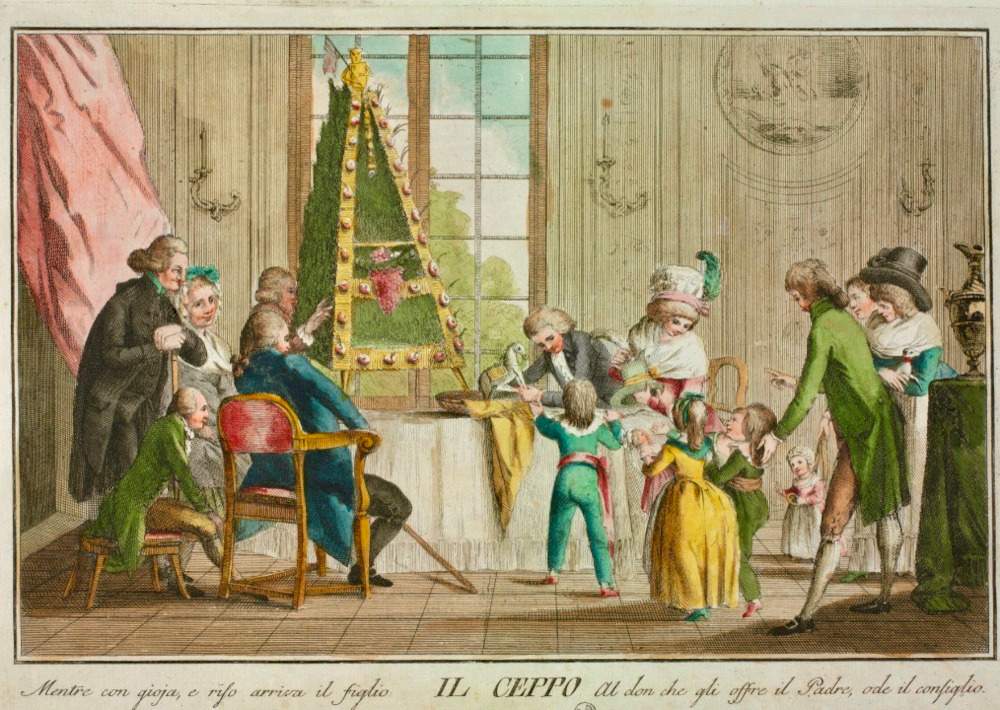The Uffizi Galleries wish everyone a Merry Christmas by recounting the more lighthearted and playful side of the Christmas Holidays experienced by children in the Grand Duchy.
Now available online and accessible to all on the museum’s website is the virtual exhibition Once Upon a Time... Ancient Tuscan Games and Traditions in the Engravings of Carlo Lasinio and Giuseppe Piattoli (1790). Thehyperview presents a series of twenty-four etchings, published in 1790 in the book by Giuseppe Piattoli and Carlo Lasinio Giuochi, Trattenimenti e Feste Annue che si costumano in Toscana specialmente in Firenze, which recounts in a satirical and burlesque style theancient Tuscan spirit of festivals.
Sweets and small gifts under the Ceppo, the ancient “Florentine-style” Christmas tree, blindfolded men and women chasing each other around the square, carriages and masks through the center of Florence, paper lanterns and blowpipes to hit them. Il Ceppo was the quintessential Christmas tradition game for Tuscan children and consisted of decorating a small log with decorations and candles. Only after completing the tree would the little ones be able to receive the gifts that the family hid under it.
On Carnival’s Maundy Thursday, the Lungarno was filled with floats and masked people drinking and eating to their heart’s content: in fact, Berlingaccio means precisely “drinking and talking.” The schiacciata alla fiorentina, the typical dessert of that occasion, concluded each banquet.
Even today on September 8 in Florence’s Piazza Santissima Annunziata, the Rificolona or fair for the feast of Our Lady is celebrated. Women would arrive in the city from the countryside dressed for the feast and carrying tall sticks with lanterns to shed light on their way. Bratty children amused themselves by throwing stones to make them fall and burn.
In the online exhibition, in addition to these typical amusements, others are illustrated such as the Beccalaglio, that is, the classic “Blind Fly”: a participant blindfolded and placed in the middle of the playing field was asked “What have you come to do in the middle of the square?” to which he replied “To peck garlic!” and after receiving the first tap from a companion the actual game would begin with the blindfolded person having to grab his companions around him.
Also famous was that of the Ball, which two teams of four players would pass to each other and hit with a wooden glove toward the wall. And again the “Pallottole,” now called bocce, a pastime that involved people from all walks of life and wealth, and which was even restricted because of the level of unrest it was capable of generating. Even today near the cathedral of Santa Maria del Fiore, a small square known as the Piazzetta delle Pallottole testifies to the immense popularity of this traditional Florentine pastime.
“Besides highlighting a series of prints belonging to the Museum’s collection,” says Uffizi Galleries director Eike Schmidt, “this virtual exhibition makes us reflect on the richness of folk traditions in Tuscany. Many games have been lost, others have evolved. And while the ’stump’ has been supplanted by the Christmas tree, typical of Nordic culture, other festivals have come down to us intact and are celebrated every year with the same spirit and a freshness that has remained intact over the centuries.”
Image: From the frontispiece, “The Log, puppet with gifts from children in the Christmas festivities.”
 |
| Uffizi: an online exhibition to tell the story of the Christmas log tradition and children's games |
Warning: the translation into English of the original Italian article was created using automatic tools. We undertake to review all articles, but we do not guarantee the total absence of inaccuracies in the translation due to the program. You can find the original by clicking on the ITA button. If you find any mistake,please contact us.